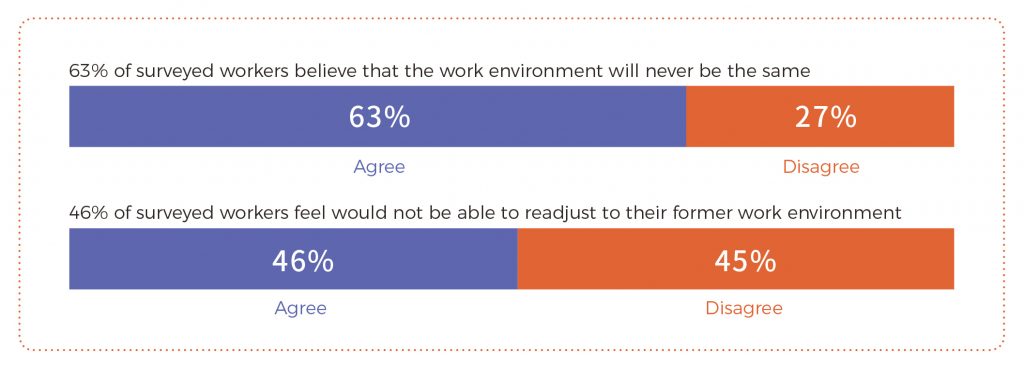THE CORONAVIRUS PANDEMIC IS EXPEDITING THE TRANSFORMATION OF THE TRADITIONAL WORK MODEL
The pandemic will eventually come to an end, but the new work model taking shape as a result is here to stay. Businesses are returning to work, but it is unlikely that the large-scale and centralized work model will reappear in many enterprises. It is now conventional for not only organizations but also individuals to take infection prevention measures in crowded work environments. In one study, 63% of surveyed workers said they believe the work environment will never be the same as before the pandemic, while 46% said they feel they would not be able to readjust to their former work environment.

Faced with unexpected circumstances, efficiency will need to be maximized in this new work paradigm. However, did you ever notice that even in a pre-pandemic work environment, most of your work was accomplished in the evenings or during late nights when nobody was around? Perhaps your day was occupied with meetings, emails, and seemingly harmless group activities that gradually decreased your productivity. With the exception of production line workers, productivity and efficiency are commonly enhanced when employees work alone for a substantial period of time. One main cause of working overtime is that you are constricted by the standard 8-hour work day. For instance, you might have a brilliant idea on Friday but are reluctant to give up your weekend, so you plan to start on it next week. But by Monday, you may no longer have the same inspiration, and the opportunity fades.
From an optimistic perspective, the coronavirus pandemic has revealed many long-standing problems related to organization and management in the enterprise. One such problem is that large-scale workplaces often end up with too many management tiers and too many workers in supervisory roles. And it doesn’t stop there. Unproductive meetings frequently interrupt the workday, insistence on face-to-face communication cuts into efficiency, job role limitations lead to client neglect, and long commutes eat up time and energy. These are problems that must be reconsidered and resolved in order to shape the new normal. Once a team switches to a new collaboration model, it is difficult to completely return to the former state. Many international IT giants have incorporated remote work positions as part of their long-term recruitment strategy.
This kind of large-scale, centralized work model hasn’t always been around. It stems from supporting the modern centralized production and management modes of the past decades. Obviously, this model is not necessarily permanent, especially since most IT services industries are not limited by large-scale production equipment.
WHY DISTRIBUTED WORK ESPECIALLY SUITS THE LOCALIZATION INDUSTRY
The localization industry inherently relies on distributed teams familiar with various languages and cultures. Because a wide variety of competencies are needed, team members need to come from diverse and often international backgrounds. Furthermore, the industry is facing a fragmented market, in which consumer attention is also increasingly fragmented. In the face of these challenges, adhering to traditional fixed office locations and long commutes only raises costs for clients and reduces service flexibility.
Technological upgrades and more-specialized services have led to modular and cloud-based office infrastructure. This trend has also seen a surge during the coronavirus pandemic. There have been more opportunities for cloud-based solutions to replace traditional IT infrastructure. The shared office model has made work easier, from shared software services to shared equipment and office spaces. Designated conference rooms are no longer the best place for discussions, as a large portion of sales are achieved without arranging formal meetings with clients. Operations management is becoming more automated, relying on machine processing whenever possible to minimize communication costs and delivery time.
Clearly Local values training and knowledge management as well as building corporate culture and organizational communication. Our work is facilitated by using official accounts, online meetings, knowledge sharing and enterprise collaboration software. We have also incorporated specialized training and activity planning that make use of every last moment. Thanks to our regular meetings and communications platform, everyone has instant access to information and we can easily stay on the same page at all times. As for project implementation and tracking, information is shared to ensure that newcomers are fully aware of the big picture. The management team also monitors whether our resources are appropriate, risks are controllable, and responsibilities are clarified.
HOW DISTRIBUTED WORK DIFFERS FROM WORK FROM HOME
With the ongoing pandemic, we have seen an increase in companies employing WFH (work from home) solutions, as well as cutting down on co-located workplaces and reducing costs. Unlike the office space, there are various distractions when working from home. This can affect productivity, especially for those who have trouble with self-management. People working from home can also experience loneliness, a feeling that is quite daunting to overcome. The lack of face-to-face interaction also heightens issues like self-control, burnout, and feeling lost with regard to individual development. For coworkers who are timid, it is even more difficult during remote work to voice opinions and communicate when problems arise. In brief, workers who need to be productive naturally have high expectations for their workspace and socialization.

The health of workers, including mental health related to issues like isolation and burnout, is one major challenge in the WFH solutions of numerous international high-tech companies. There are also times when face-to-face interaction is necessary, as in the case of equipment testing. We do not recommend overly simplistic WFH strategies that neglect issues like monitoring productivity and mental health.
The distributed work model has more advantages with regard to overcoming the above challenges. Clearly Local cooperates with coworking space chains around the world to provide quality and low-cost workspaces for the global workforce trend. Another advantage is location flexibility, which can minimize commute time. Last but not least, we cover a wider domain by recruiting talent from all different cities as needed, rather than being restricted by location. Although members of the same team may not work in one office, there is a diversity of talent with different positions working in each coworking office space. This diversity helps create a dynamic and tangible team atmosphere in the work life.
In contrast to WFH, distributed work resolves issues related to the work environment, equipment and hardware, and social interaction. We use cloud technology to record when employees clock in at different office spaces. We estimate that the distributed work model has saved us over 20% on office work expenses and related IT infrastructure expenses. The office size can be adjusted to match the needs of the workers on a monthly basis, eliminating wasted space. Clearly Local converts the resulting savings into effective ways to benefit our clients and motivate our team.
REAFFIRMING OUR VALUE ORIENTATION
The recent changes have given us a chance to evaluate our value orientation, and consider whether it has been fully applied throughout our business. This opportunity also calls for reflection on whether each procedure has added value for our clients, whether we constantly adapt to the latest situations, and whether these adjustments are impaired by organizational structure, work ethics, or locations.
We have replaced KPI with KSF in the new work model so that the whole team can reach a consensus on goals and results. We have also kept our goals consistent and transparent while ensuring that the team can feel accomplished through their work. This is important particularly for remote teams, as teams with a shared objective can collaborate more effectively.
Distributed work depends ultimately on management styles, which can range from more conformed and supervised to more value-driven and profit-driven. In modes of work we traditionally considered superior, it was impossible to achieve complete freedom, decentralization, and sharing. Long documents, academic tone, and flashy advertisements may leave an impression on clients, and office buildings, luxurious decorations, and seemingly high-end services may be nice. But in the end, what clients expect is an ability to resolve problems and transparency of services. A company that can truly integrate its organizational structure with customer values will end up with the most opportunities.



